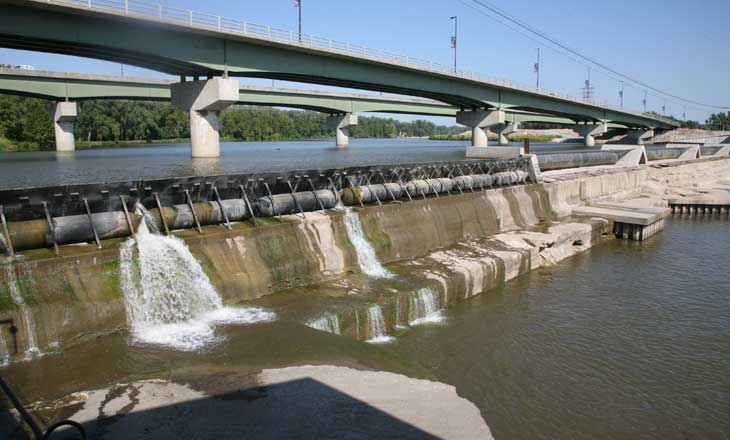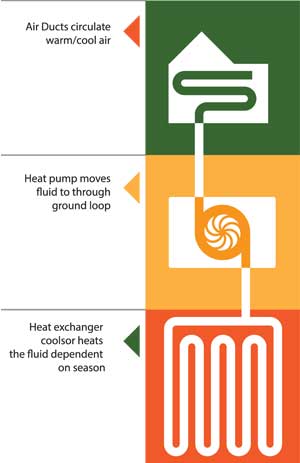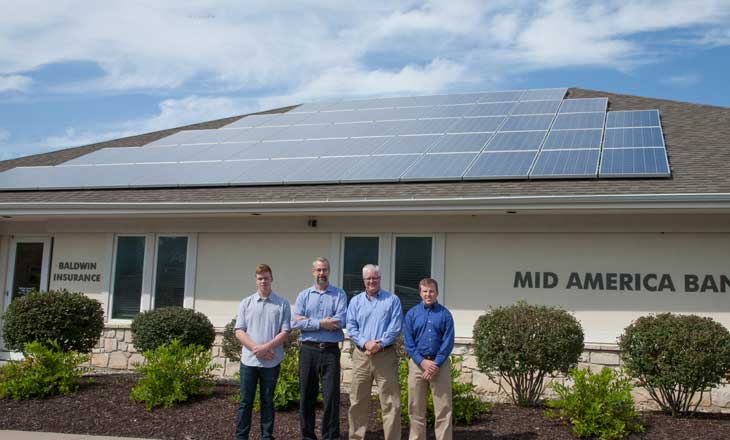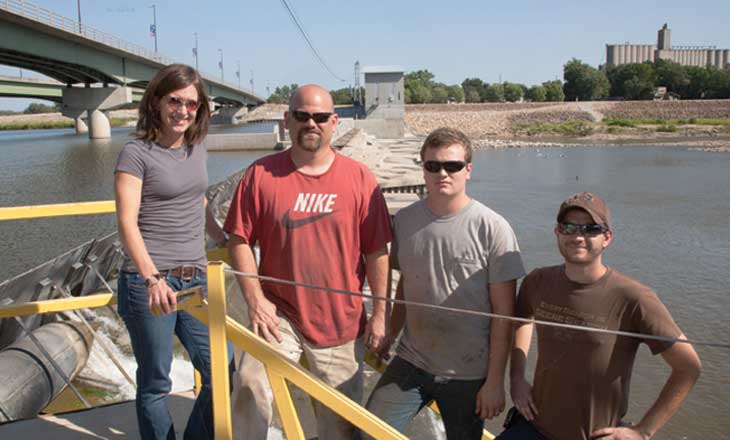| 2013 Summer | story by EMILY MULLIGAN | photos by STEVEN HERTZOG |

As politicians nationwide continue to discuss ways to make Americans less dependent on foreign oil and environmentalists protest construction of a new coal plant in Kansas, some alternative energy methods are getting a stronger foothold in Lawrence and Douglas County.
Wind turbines won’t be gracing downtown anytime soon, but geothermal power, solar power and hydroelectric power all have an emerging presence in the area.
GEOTHERMAL
Geothermal heat pumps are an energy alternative that is just beginning to emerge in the area. Prices have remained steady over the years, but a 30% tax credit is prompting builders, architects and homebuyers to consider the technology more readily, said Sarajane Scott of Scott Temperature Equipment.
Geothermal heat pumps employ a series of pipes about 4 feet underground that use the Earth’s natural temperature to heat or cool a home by pumping liquid through the system. The ground’s temperature at that depth in this area stays about 55 degrees year-round, Scott said. That means it is cooler than the air in the summer and warmer than the air in the winter. Even when there are extreme temperatures outside, the geothermal heat pump maintains an equilibrium that makes it much more efficient than air-source heat pumps or traditional air-exchange HVAC equipment. An optional component with the geothermal heat pumps also allows for water heating, in place of a traditional water heater.
Shane Lyle, a geologist with the Kansas Geological Survey, said that geothermal heat pumps were becoming more popular as buildings are built or retrofitted to become LEED certified.
 Scott said that geothermal heat pumps decreased utility bills by 30 to 60 percent. Because of the digging required to install them, it only makes sense to install geothermal technology for new construction or major renovations.
Scott said that geothermal heat pumps decreased utility bills by 30 to 60 percent. Because of the digging required to install them, it only makes sense to install geothermal technology for new construction or major renovations.
“In comparison to air-exchange heating and cooling, the energy usage is much lower, so it is greener,” Lyle said. “But there is an initial investment cost that has to be overcome.”
According to Scott, adding geothermal would start at about $14,000. When installing geothermal in new construction, the price includes all of the ductwork and sealed ductwork in the house, with a total price starting at about $18,000. Subtract the tax credit and calculate utility bill savings, and the system can pay for itself in seven to 10 years. Scott Temperature is receiving more calls from builders inquiring about the technology, as new home construction has begun to pick up in the area.
Two scholarship halls at the University of Kansas, Reiger and Krehbiel, have geothermal heat pumps that were installed when the buildings were constructed in 2004 and 2008, respectively.
“The initial cost hit isn’t big to an institution like KU or an office building where they’re going to use a lot of energy, and it pays for itself more quickly,” Lyle said. “In the scholarship hall, where they have a number of people who live there, that maintains a steady revenue stream to recover the installation costs.”
The Castle Tea Room event space on Massachusetts St. was fitted with a geothermal heat pump when it underwent extensive renovations in 2009.
The Scott Temperature Equipment office building is heated and cooled by a geothermal heat pump they installed last year, Scott said. Scott Temperature also installed geothermal technology in Habitat for Humanity homes in North Lawrence.
SOLAR POWER
Solar panel prices have been going down for the past few years, and there is a 20% federal tax credit available for solar panel installation. Couple that with a successful local solar panel installation company, Cromwell Environmental, and more and more businesses and residents are opting to put solar panels on their south-facing roofs.

Solar panels, also called photovoltaic panels, use silicone to transmit energy from the sun to wires inside the panels that then connect with a home or building’s electrical system.
Cromwell installed solar panels on the Poehler lofts in East Lawrence when they were renovated, and Hilary’s Eat Well, a veggie burger manufacturer, recently fitted its headquarter building with solar panels. Even downtown businesses have made solar power work for them, as both Sunflower Outdoor and Liberty Hall installed solar panels within the past year.
 Given the low maintenance, decreasing prices and other factors, such as geography, solar power makes more sense than other options for businesses in the area, said Scott White, founder of the Kansas Energy Information Network (KEIN), a compendium of energy news and projects in the Great Plains.
Given the low maintenance, decreasing prices and other factors, such as geography, solar power makes more sense than other options for businesses in the area, said Scott White, founder of the Kansas Energy Information Network (KEIN), a compendium of energy news and projects in the Great Plains.
“Solar is really what is happening in Lawrence right now,” White said. “Wind turbines are the same price as solar, but they have moving parts and you have to maintain them. Because we are in the Kansas River valley, the trees and hills would block wind from the turbines. We would have to put the turbines too high to get them to work properly.”
Solar panel prices will likely continue to decline, whereas natural gas prices will fluctuate and probably go up, so solar is a more stable financial option, White added.
HYDROELECTRIC
The presence of Hydroelectric power is clear to anyone crossing the Kansas River north of downtown. Bowersock Mills & Power Co. completed its hydroelectric power plant on the north bank of the Kaw in 2012.
“In part, the visibility of our new building has raised the community’s awareness of energy just by its physical presence,” said Sarah Hill-Nelson, co-owner and manager of the Bowersock Mills & Power Company. “Now that this plant is here, not only are people thinking about hydroelectric power, but electricity. They’re asking, ‘Where does the rest of our electricity come from?’”
Hydroelectric power uses the motion of the water to spin a turbine, which then turns a generator and creates electricity. That electricity is then transmitted along traditional wires and poles.
 Although the plant is located in Lawrence and employs local workers, all of the power it generates is sent downriver to the Kansas City Board of Public Utilities customers in Wyandotte County. The past two times Bowersock has solicited bids for a Purchase Power Agreement, it has chosen someone other than Westar, which the electricity provider for Lawrence and Douglas County.
Although the plant is located in Lawrence and employs local workers, all of the power it generates is sent downriver to the Kansas City Board of Public Utilities customers in Wyandotte County. The past two times Bowersock has solicited bids for a Purchase Power Agreement, it has chosen someone other than Westar, which the electricity provider for Lawrence and Douglas County.
“It doesn’t affect us pricewise, but we got a new dam out of it,” White said.
 Bowersock’s impact isn’t just green in the environmental sense; it’s also green in the financial sense.
Bowersock’s impact isn’t just green in the environmental sense; it’s also green in the financial sense.
“Through the construction process, we spent a ton of money in Lawrence. We tried to give preference to Kansas and Lawrence suppliers when at all possible – down to the fact we spent a lot of time eating at Johnny’s Tavern,” Hill-Nelson said.
Bowersock is the only place in Kansas where it makes physical and financial sense to generate electricity, White said.
“Some groups have analyzed every dam on the lakes in Kansas. The costs of revamping the dams for hydroelectric power are not worth it,” he said.
Hill-Nelson said that nationwide, only about 3 percent of dams have hydropower production on them. So, the potential is huge – possibly as much as the equivalent of 70 nuclear power plants, according to research – if more dams in the U.S. were to be equipped.
She said that, in combination, all the methods of alternative energy generation make the electrical grid more localized and potentially stronger.
“Our distribution system is becoming more robust and powerful,” Hill-Nelson said. “There are little hydro plants, people have solar panels on their roofs, and there is wind power. You’re going to have a much more diverse, stable grid.” ■
